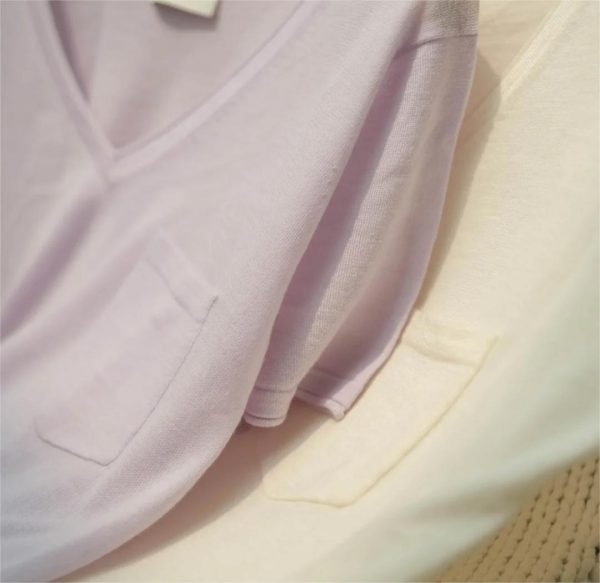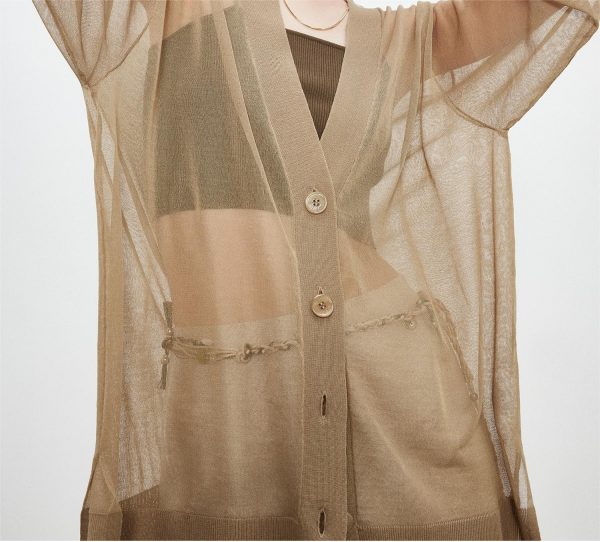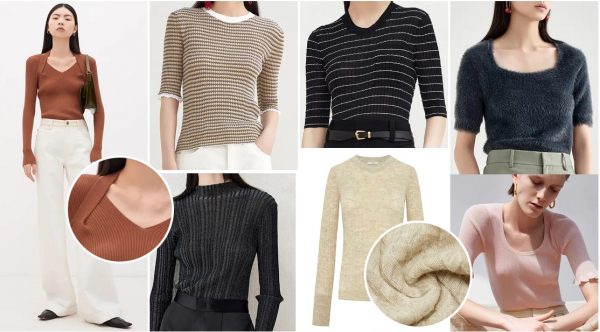Choosing the right stuff for your custom knitwear is key to making sure they work great, feel nice, and last a long time. The materials you go with affect the look and feel of your knitwear, plus how well it stays in shape as time goes by. Whether you’re designing cozy sweaters, fashionable cardigans, or versatile outfits, getting to know about various fibers helps you pick what’s best for your style and needs.
The significance of selecting the appropriate materials must be balanced. High-quality materials can enhance the wearability of knitwear, making it more comfortable and enjoyable to use. On the other hand, poor material choices can lead to issues such as discomfort, rapid wear and tear, and dissatisfaction with the final product. By carefully considering factors such as texture, durability, and environmental impact, you can create knitwear that looks great and stands the test of time.
Overview of Key Benefits
Opting for the right materials for your custom knitwear brings several key benefits:
- Improved Quality: High-quality materials ensure that the custom knitwear is durable, retains its shape, and remains aesthetically pleasing. For instance, natural fibers like wool and silk are renowned for their superior quality and luxurious feel. Learn more about the benefits of natural fibers.
- Enhanced Comfort: Materials such as cotton and merino wool offer excellent breathability and softness, making them ideal for garments that come in direct contact with the skin. This is particularly important for everyday wear and items intended for individuals with sensitive skin. Explore the comfort of natural fibers.
- Sustainability: Choosing eco-friendly materials is essential for minimizing the environmental impact of your knitwear. Sustainable options like organic cotton and recycled fibers reduce waste and conserve resources. Discover sustainable knitwear options.
- Versatility: Different materials can be combined to create unique blends that offer both functionality and style. For example, wool-cotton blends combine the warmth of wool with the softness and breathability of cotton, making them suitable for various climates and occasions. Read about material blends in knitwear.
- Cost-Effectiveness: While high-quality materials may come at a higher initial cost, they often provide better value in the long run due to their durability and performance. Quality materials can save you money on replacements and repairs over time. Learn about cost-effective knitwear materials.
By understanding and leveraging these benefits, you can elevate the quality of your custom knitwear projects and deliver products that delight your customers and stand out in the market.
Understanding Knitwear Materials and Popular Choices
Knitwear materials form the backbone of any knitwear project, greatly influencing the final product’s texture, comfort, elasticity, and appearance. Knitwear is created by interlocking loops of yarn together, and the material chosen significantly impacts the overall quality and functionality of the garment. One must understand the different types of yarns available and their unique properties to choose the best material.
Knitwear materials can be categorized into natural fibers and synthetic fibers. Each type offers distinct characteristics that cater to different needs and preferences. From the luxurious feel of cashmere to the sturdy practicality of acrylic, understanding these materials will help you make informed choices for your custom knitwear projects.
- Roles and Popular Choices of Different Materials
Different materials play crucial roles in determining the suitability of custom knitwear for various applications. Here’s an in-depth look at the roles, characteristics, and popular choices of knitwear materials:
1. Natural Fibers:

– Wool: Wool is celebrated for its excellent insulation and versatility. It includes various types such as:
– *Australian Wool: Known for its superior quality and softness, it is often used in premium knitwear.
– *Merino Wool: Merino wool is highly sought after for its incredible softness, breathability, and insulating properties. Sourced from Merino sheep, this fiber is finer than traditional wool, making it less itchy and more comfortable against the skin. Merino wool is versatile, perfect for a range of garments from sweaters to socks. Discover more about Merino wool.
– *Basolan Wool: A treatment process that enhances wool’s durability and softness, making it suitable for machine washing.
– *Shrink-proof Wool: Treated to prevent shrinking, ensuring longevity and ease of care.
– *Machine Washable Wool: Processed to withstand machine washing without damage, perfect for easy-care garments.
– *Mercerized Wool: Treated for added luster and strength, resulting in a silky texture and vibrant colors. Explore the benefits of wool.
– Cotton: Lightweight, breathable, and easy to care for, cotton is ideal for summer garments and those with sensitive skin. Cotton knitwear is highly absorbent and can be easily dyed, offering wide design possibilities. Organic cotton is gaining popularity for its environmental benefits. Learn about the advantages of cotton.
– Silk: Known for its natural shine, smooth texture, and strength, silk drapes beautifully and offers excellent temperature regulation, making it comfortable in both warm and cool climates. Additionally, it is hypoallergenic and gentle on the skin. Learn more about the benefits of silk.
– Cashmere: Renowned for its unparalleled softness and warmth, cashmere provides excellent insulation without being bulky. Perfect for high-end sweaters and accessories, cashmere is breathable and adapts to the body’s temperature, offering comfort in various climates. Explore the luxury of cashmere.
2. Synthetic Fibers:
– Acrylic: A versatile and affordable fiber that mimics the properties of wool. Acrylic is lightweight, warm, and resistant to moths and mildew. It is often blended with other fibers to enhance durability and reduce costs. Understand the properties of acrylic.
– Nylon: Known for its strength and elasticity, nylon adds stretch and resilience to knitwear. It is durable and resistant to abrasions, making it an excellent choice for activewear and hosiery. Learn about nylon’s role in knitwear.
– Polyester: Durable, quick-drying, and resistant to wrinkles, polyester is often blended with natural fibers to enhance longevity and performance. Find out more about polyester in clothing.
3. Blended Materials:
Blended materials combine the best attributes of different fibers to create yarns that offer enhanced performance, comfort, and value. Blends can be made between natural fibers, natural and synthetic fibers, or purely synthetic fibers. Here, we focus on common wool blends:
– Wool-Cotton Blends: Combining wool and cotton creates a fabric that merges the best properties of both materials. The result is a custom knitwear that is both warm and breathable, suitable for various seasons. This blend balances structure and flexibility, making it easier to design versatile and comfortable garments. Learn about wool-cotton blends.
– Wool-Silk Blends: This blend offers the warmth and durability of wool along with the sheen and softness of silk. Wool-silk blended knitwear tends to have a luxurious appearance and feel, making it a favorite for premium clothing lines. Explore wool-silk blend benefits.
For more information on other types of materials, please contact us. When contacting us, please send us technical packages, pictures, or links and we will provide you with yarn solutions for free.
By understanding the roles, characteristics, and popular choices of different knitwear materials, you can make better choices that align with your project’s requirements and desired outcomes.
Tips for Custom Knitwear Material Selection
Choosing the right custom knitwear material is critical to ensuring the final product meets your expectations in terms of aesthetics, functionality, and price. Here are some tips to help you make an informed decision for your custom knitwear project.
- Matching Materials to Designs: Material Impact on Aesthetic


The choice of material has a significant impact on the overall look and feel of the design. Different fibers offer distinct textures, sheens, and drapes, which can alter the appearance and style of your custom knitwear. For instance:
– Silk: Known for its natural shine and smooth texture, silk provides a luxurious and elegant look, perfect for evening wear or high-end garments. Its light drape makes it ideal for fluid, flowing designs. Learn more about the properties of silk.
– Wool: This material offers warmth and texture, making it suitable for cozy winter garments. Depending on the type, it can range from soft and fine (like Merino wool) to thick and rustic. Discover the benefits of various types of wool.
– Cotton: Cotton’s breathable and lightweight nature makes it excellent for casual wear. It provides a matte finish and is easy to dye, allowing for vibrant colors in your designs. Explore the versatility of cotton.
When selecting materials, consider how each one’s unique characteristics will complement or enhance your design. For instance, a delicate lace pattern might benefit from a fine, silky yarn, while a chunky cable knit sweater would look great in thick, durable wool.
- Blending Materials for Optimal Performance: Strength, Stretch, and Comfort
Blending different fibers can harness the best properties of each, resulting in a material that offers enhanced performance. For example:
– Wool and Nylon: This blend combines the warmth and breathability of wool with the strength and elasticity of nylon, creating a durable yet comfortable fabric suitable for activewear or everyday garments.
– Cotton and Polyester: Cotton adds softness and breathability, while polyester enhances durability and wrinkle resistance. This blend is ideal for casual wear that needs to withstand frequent washing and wear.
– Silk and Wool: This luxurious blend offers the warmth and softness of wool with the sheen and drape of silk. It’s perfect for high-end knitwear that requires both comfort and style.
Combining fibers allows for the creation of knitwear that is not only aesthetically pleasing but also highly functional. For those seeking optimal performance in their garments, searching for “best material blends for knitwear” can provide valuable insights and recommended combinations.
- Choose yarn within your budget for your custom knitwear
Цена пряжи может сильно варьироваться в зависимости от типа используемого волокна:
1. Budget-Friendly Yarns
– Смесовая пряжа с вискозой, нейлоном, хлопком, акрилом:
Эти смеси представляют собой экономичный вариант, сохраняя при этом такие желаемые качества, как воздухопроницаемость и долговечность.
– Базовые смеси хлопка и синтетических материалов:
Широко доступные натуральные волокна, такие как хлопок и синтетические смеси, обеспечивают баланс между стоимостью и качеством.
2. Mid-Range Yarns
– Лен, конопля, высококачественный хлопок, смесь шерсти с низким содержанием шерсти, чистая шерсть:
Эти волокна обеспечивают более высокое качество и лучшую производительность и подходят для тех, кто ищет улучшенные ощущения и долговечность, не тратя при этом денег.
3. Luxury Yarns
– Высококачественная шерсть животных (альпака, кашемир, мохер, ангора):
Эти волокна известны своей превосходной мягкостью, теплом и текстурой.
– Высококачественные специальные волокна и пряжа, окрашенная вручную:
Они созданы для рынков премиум-класса и предлагают уникальные цвета и текстуры.
Кроме того, даже в пределах одного и того же состава волокна пряжа может различаться по классу. Дизайнеры, которые не уверены в том, какая пряжа лучше всего подойдет для их проектов, могут отправить запрос. Мы предлагаем бесплатную консультацию по пряже с учетом ваших дизайнерских потребностей и бюджета, гарантируя, что вы получите лучшее решение.
- Considering End-Use: Selecting Materials Based on Use
The intended use of custom knitwear significantly influences material choice. Different applications require different properties from the material to ensure functionality and comfort. Here’s how to choose materials based on the end-use:
– Casual Wear: For everyday garments, comfort and ease of care are key. Materials like cotton, bamboo, or blends that include soft synthetics, provide breathability and are easy to maintain.
– Athletic Wear: Performance fabrics that offer moisture-wicking, stretch, and durability are essential. Blends incorporating nylon, spandex, and polyester work well for activewear, ensuring the garment moves with the body while remaining robust.
– Luxury Items: High-end knitwear benefits from premium materials like cashmere, silk, and fine Merino wool. These fibers offer exceptional softness, warmth, and a luxurious feel, making them perfect for special occasion garments.
Matching materials to their intended use ensures that the custom knitwear not only looks good but also performs well in its designated role. By considering factors such as comfort, durability, and the desired aesthetic, you can select the perfect materials for your custom knitwear.
—
By understanding these crucial aspects of material selection, you can ensure that your custom knitwear projects are visually appealing but also functional and durable. For further guidance, don’t hesitate to reach out and contact us.

 English
English Deutsch
Deutsch Français
Français Italiano
Italiano Español
Español Русский
Русский Polski
Polski Nederlands
Nederlands Svenska
Svenska

